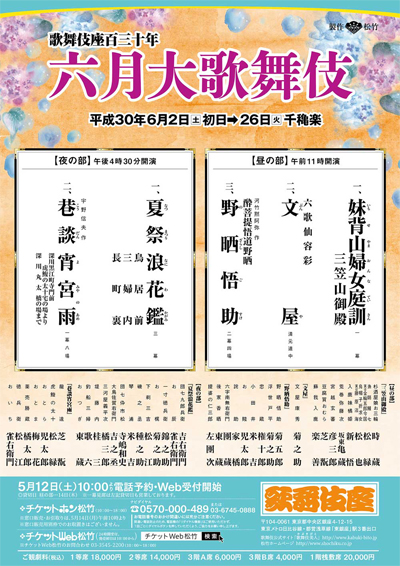| JUNE 2018 |
|
3 shows in T˘ky˘ (Kabukiza, National Theatre), 1 in Matsumoto (Matsumoto Performing Arts Centre) and 2 in Fukuoka (Hakataza)!
|
| Kabukiza (T˘ky˘) |  |
| Dates | 2 ~ 26 June 2018 Rokugatsu ďkabuki June Grand Kabuki |
| MatinÚe |
Imoseyama Onna Teikin Rokkasen Sugata no Irodori (Bun'ya) Nozarashi Gosuke |
| Evening |
|
| Casting |
Living National Treasure Onoe Kikugor˘, Living National Treasure Nakamura Kichiemon, Living National Treasure Nakamura T˘z˘, Nakamura Jakuemon, Nakamura Tokiz˘, Nakamura Shikan, Onoe Kikunosuke, Nakamura Kinnosuke, Onoe Sh˘roku, Ichikawa Sadanji, Ichikawa Danz˘, Band˘ Rakuzen, Band˘ Hikosabur˘, Band˘ Kamez˘, Ichimura Kakitsu, Kawarasaki Gonjűr˘, Onoe Matsuya, Nakamura Matsue, ďtani Keiz˘, Nakamura Kotar˘, Nakamura Yonekichi, Band˘ Shingo, Nakamura Tanenosuke, Arashi Kitsusabur˘, Nakamura Kichinoj˘, Nakamura Baika, Ichimura Kitsutar˘, Terashima Kazufumi |
| Comments |
The traditional programs for the June Grand Kabuki at the Kabukiza.
|
 |
|
|||
| Dates | 2 ~ 26 June 2018 Rokugatsu Hakataza ďkabuki June Hakataza Grand Kabuki |
||
| MatinÚe | |||
| Evening |
Heike Nyogo no Shima (Shunkan) |
||
| Casting |
Matsumoto Haku˘, Matsumoto K˘shir˘, Living National Treasure Sakata T˘jűr˘, Living National Treasure Kataoka Nizaemon, Nakamura Baigyoku, Nakamura Kaishun, Nakamura Ganjir˘, Kataoka Takatar˘, Band˘ Yajűr˘, ďtani Tomoemon, Ichikawa Emisabur˘, Ichikawa Emiya, Nakamura Kazutar˘, Ichikawa Komaz˘, Kamimura Kichiya, Nakamura Kikaku, Ichikawa En'ya, Sawamura S˘nosuke, Matsumoto Kingo, ďtani Hirotar˘ |
||
| Comments |
The traditional two programs for the June Grand Kabuki at the Hakataza. Matsumoto Haku˘ II and his son Matsumoto K˘shir˘ X celebrate their shűmei in Fukuoka at the Hakataza!
|
||
 |
| National Theatre (T˘ky˘) |
| Dates | 2 ~ 24 June 2018 Rokugatsu Kabuki Kansh˘ Ky˘shitsu June Kabuki Appreciation Class |
| Program | |
| Casting |
Nakamura Matagor˘, Nakamura Kash˘, Nakamura Hayato, Nakamura Fukunosuke |
| Comments |
Educational program at the National Theatre called Kabuki Kansh˘ Ky˘shitu ('Kabuki Appreciation Class'). This is a very interesting formula for the beginners because there is lively presentation on stage of Kabuki or some aspects of the art like music, stage tricks or fighting scenes. It is followed by the dance-drama "Renjishi".
|
|
|||
| Dates | 12 ~ 18 June 2018 (Shinshű Matsumoto ďkabuki) Shinshű Matsumoto Grand Kabuki |
||
| Program | |||
| Casting |
Nakamura Shichinosuke, Nakamura Senjaku, Kataoka Kamez˘, Nakamura Baishi, Nakamura Mantar˘, Sasano Takashi |
||
| Comments |
6th edition in the city of Matsumoto (first time in July 2008; second time in July 2010; third time in July 2012; fourth time in July 2014); fifth time in July 2016) of a Kabuki program, which is called Shinshű Matsumoto ďkabuki (Shinshű is an old name for the province of Nagano, whose main city is Matsumoto). Same program as the 16th edition of the Cocoon Kabuki in T˘ky˘:
|
||
|
|
| Contact | Main | Top | Updates | Actors | Plays | Playwrights | Programs | Links | FAQ | Glossary | Chronology | Illustrations | Prints | Characters | Derivatives | Theaters | Coming soon | News |

